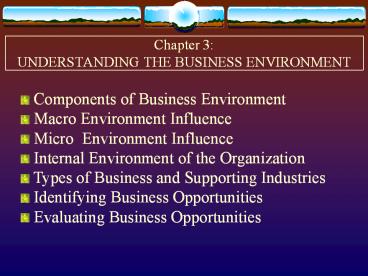Chapter 3: UNDERSTANDING THE BUSINESS ENVIRONMENT - PowerPoint PPT Presentation
Title:
Chapter 3: UNDERSTANDING THE BUSINESS ENVIRONMENT
Description:
Chapter 3: UNDERSTANDING THE BUSINESS ENVIRONMENT Components of Business Environment Macro Environment Influence Micro Environment Influence Internal Environment of ... – PowerPoint PPT presentation
Number of Views:520
Avg rating:3.0/5.0
Title: Chapter 3: UNDERSTANDING THE BUSINESS ENVIRONMENT
1
Chapter 3UNDERSTANDING THE BUSINESS ENVIRONMENT
- Components of Business Environment
- Macro Environment Influence
- Micro Environment Influence
- Internal Environment of the Organization
- Types of Business and Supporting Industries
- Identifying Business Opportunities
- Evaluating Business Opportunities
2
Components of Business Environment
- Environmental scanning can lead to an idea that
can be converted into a business opportunity. - Two approaches in scanning the environment
- a. macro perspectives
- b. micro perspective.
3
Components of Business Environment
- Example the agricultural sector
Agricultural Sector
Forestry
Fishing
Plantation
Poultry
- Veneer plywood
- Logging
- Furniture
- Sawn timber
- Fishing equipment
- Deep-sea fishing
- Fishing processing
- Wholesales/distribution
- Clearing plantation
- Planting
- Processing
- Wholesales/supplies
- Poultry farming
- Processing
- Wholesales/supplies
4
Components of Business Environment
- Macro perspective agricultural sector offer
business opportunities in forestry, fishing,
plantation and poultry industries. - Micro perspective each industry offer specific
business opportunities. Eg. Poultry?
5
Macro Environment Influence
- Factors in macro environment
- a. socio-cultural
- b. political and legislation
- c. economy
- d. technology
6
Macro Environment Influence
- Socio-cultural factors. Demographic and cultural
trends. - - demographics ethnic group, age, gender,
geographic location, distribution of income. - - social trends lifestyle, tastes and
preferences. - Political and legislation. Policy, legislation
regulations. - - trade barriers, political risks, trade
agreement, taxation, government
spending.
7
Macro Environment Influence
- Economy. Current state of the economy, labour
market, interest rates, currency value/foreign
exchange rate, overeseas opportunities, etc. - Technology. Technology changes takes 2 forms
pure invention or process invention. - pure invention semiconductors.
- process invention small changes in design,
product formulation, manufacturing, materials and
distribution.
8
Micro Environment Influence
- Factors in micro environment
- a. Consumers
- b. Competitors
- c. Suppliers
- d. Financial institutions
- e. Government agencies
- f. Non-government organizations
9
Micro Environment Influence
- Consumers. Main target group. Maybe individuals,
or groups of people, or industrial buyers
(dealers, agents, wholesalers, retailers. - Competitors. Businesses that fulfill the same
customer needs or have the potential to serve
those customers. Can be identified through
customers input or business directories.
10
Micro Environment Influence
c. Suppliers. Influence the price and quality of
products supplied. d. Financial institutions.
Provide loans. Influence loan amount, duration
and interest/dividend rates e. Government
agencies. Provide various incentives, training,
other types of support. d. Non-government
organizations. Chambers of commerce, consumer
groups, religious groups, environmental groups.
11
Internal Environment of the Organization
- Resources. Skills, ideas, knowledge and
experiences, financial, human resources,
technology, reputation (image). - Structure. Structure and strategy must fit.
- Culture. Inculcate positive corporate culture.
How?
12
Types of Business and Supporting Industries
- The output of an industry may require input from
other industries. - This form industrial linkages among industries
from the same sector or other sectors.
- Forward linkage
- Car distribution
- Service workshop
- Supplier of spare parts
- Car rental service
- Taxi company
- Backward linkage
- Component industry
- Transportation
- Tyre industry
- Cleaning service
- Supplier of equipment
- office supplies
National Car Project
13
Identifying Business Opportunities
- Four major steps in identifying, evaluating and
selecting a business opportunity. - 1. Identifying the needs and wants of customers
- 2. Scanning the environment and evaluating of
self and the community. - 3. Screening of business opportunities.
- 4. Selecting a business opportunity and
preparing a business plan.
14
Evaluating Business Opportunities
- Experience
- Knowledge and skill
- Financial situation
- Interest
- Networking
- Values/Norms of the community
15
Evaluating Business Opportunities
- Experience. Many entrepreneurs involved in
businesses - that are suited to their own experience.
- Knowledge and skill. To establish whether that
someone really knows what to do. - Financial situation. Financially able. Access to
sources of fund. Financially viable.
16
Evaluating Business Opportunities
- Interest. Interest give more confidence and a
sense of responsibility. - Networking. Establish network to expedite
business processes. - Values/Norms of the community. Business
opportunities must be coordinated with the values
or norms of the community.
17
Screening Business Opportunities
- Legality.
- Monopolistic power and level of competition.
- Capital requirements.
- Risks.
18
Screening Business Opportunities
- Legality. Ensure business opportunity is legal.
- Monopolistic power and level of competition.
Business opportunity is not monopolized. Rank
the level of competition. - Capital requirements. Business opportunity
chosen must be appropriate for the financial
resources available in order to avoid financial
problems in the future. - Risks. Evaluate risks. Level of risk depends on
three factors difficulty or ease to enter a
business, size of capital and profit margin.
19
Changing Environmental Trend
- Economic trends
- Teenagers with more cash
- and disposal income
Resulting new business, product and service
opportunities
- Designer cloths, compact discs, DVD players,
games and consoles, handheld computers.
20
Changing Environmental Trend
Resulting new business, product and service
opportunities
- Social trends
- Increased interest in
- fitness
Fitness centers, in-house exercise equipment,
weight-loss centers, health food stores.
21
Changing Environmental Trend
Resulting new business, product and service
opportunities
- Technological trends
- Advances in biotechnology
- Biotech related pharmaceutical
- products, food products, veterinary
- products, information services.
22
Changing Environmental Trend
Resulting new business, product and service
opportunities
- Political and Regulatory trends
- Increased EPA and OSHA standards
- Consulting companies, software to monitor
compliance, products to help ensure compliance.
23
NEW PRODUCT COMMERCIALISATION?































